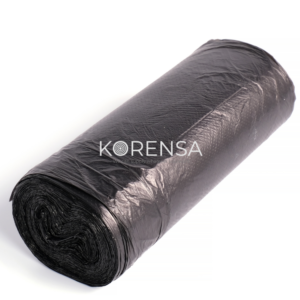Our Biohazard garbage bags are produced from 100% virgin polyethylene and 100% recycled materials. Minimum single layer thickness is 15 microns and above can be made. C-fold (flat bottom) can be made in desired thickness and star-folded (star bottom) can be made at low microns.
Biohazard Garbage Bags: Technical Information and Description
Biohazard garbage bags are specially designed to handle hazardous waste, specifically materials that are potentially harmful to health or the environment. These bags are commonly used in medical, laboratory, and industrial settings where contaminated materials like biological substances, chemicals, and other toxic waste need to be safely disposed of. Here are the key features and technical details of biohazard garbage bags:
1. Material Composition
Biohazard bags are typically made from durable plastic materials such as HDPE (High-Density Polyethylene) or LDPE (Low-Density Polyethylene). These materials offer high resistance to punctures, tears, and leaks, ensuring that harmful substances remain contained.
2. Strength and Durability
- Thickness: Biohazard bags usually come in a range of thicknesses from 0.8 mil to 4 mil (or higher), depending on the intended use and the nature of the waste. Thicker bags provide additional strength for handling heavier and more abrasive waste.
- Tensile Strength: Biohazard bags are manufactured to withstand the weight and pressure of hazardous waste without breaking or tearing. Tensile strength refers to the bag’s resistance to stretching or breaking under tension.
3. Color and Markings
- Color: These bags are often bright yellow or red to clearly indicate their hazardous content, helping to prevent accidental handling. Some also feature black or clear designs, depending on specific requirements.
- Markings: The bags are typically marked with a biohazard symbol (usually in black), along with clear labels such as “BIOHAZARD,” “HAZARDOUS WASTE,” or other relevant warnings. This ensures that workers handling the bags are aware of the dangerous materials inside.
4. Sealing and Closure
Biohazard garbage bags come with secure sealing options such as drawstring closures, twist ties, or heat-sealed edges. These closures ensure that the bag remains sealed during transportation, preventing any spillage or contamination.
5. Usage and Applications
- Healthcare and Medical: Used for disposing of items like contaminated gloves, gowns, bandages, and surgical waste from hospitals, clinics, and laboratories.
- Industrial and Manufacturing: Used for handling industrial waste, including chemicals, asbestos, and any waste material classified as hazardous under health and safety guidelines.
- Laboratories: Utilized for disposing of biological specimens, petri dishes, culture plates, and anything that may pose an infectious risk.
6. Environmental Considerations
While biohazard bags are necessary for safely containing hazardous materials, their environmental impact is a concern. Many biohazard bags are made from recyclable plastics, and there is a growing push for manufacturers to create more environmentally friendly alternatives, such as biodegradable options, without compromising safety standards.
7. Compliance and Standards
Biohazard garbage bags must meet regulatory requirements set by authorities like the Occupational Safety and Health Administration (OSHA), the Environmental Protection Agency (EPA), and other relevant bodies. Compliance with these standards ensures that the bags provide adequate protection during waste disposal and handling.
8. Disposal and Handling
When handling biohazard waste, it is important to follow appropriate disposal protocols. This typically involves placing the waste in designated biohazard containers before using these specialized bags for safe removal and disposal according to local regulations.
In summary, biohazard garbage bags are essential tools for maintaining safety and hygiene in environments that deal with potentially harmful biological and chemical waste. Their design focuses on durability, safety, and ease of handling, ensuring hazardous materials are contained and disposed of properly.


 Türkçe
Türkçe













